Join our WhatsApp Channel for free information about snakes & snakebite as well as notifications of our latest specials!
Not every green snake is a Green Mamba.
We spend a lot of time on social media spreading snake awareness and education and one of the comments we see most often on any photograph of a green snake is “it’s a Green Mamba!”.
Because of their size and distribution throughout Africa – Green Mambas are the best known of all green snakes – followed closely by the Boomslang.
However, in southern Africa there are an additional nine species of green snakes which may be misidentified for the Green Mamba. Many of the harmless green snakes, such as the Spotted Bush Snake or Natal green snakes, are very common and are often found in gardens or even in houses.
As part of our on-going snake awareness initiative, we’ve put together a list of key points to look out for when identifying green snakes.
Why is it not a Green Mamba?
Distribution
The first rule in identifying snakes is location. Green Mambas have a limited distribution in southern Africa. They are an east coast species, occurring from around Port St Johns in the Eastern Cape, along the coast into KwaZulu-Natal eastward into Mozambique and north into East Africa. In most of South Africa they are usually found within 3-5 km from the sea, but in northern KwaZulu-Natal they may extend inland as far as 45 km. In Mozambique they largely hug the coast but do extend inland around Vilankulos and extend into the thick forests around the Zimbabwean Eastern Highlands. They are also known from inland regions of Malawi but remain coastal in Tanzania and Kenya. This snake prefers tropical climates of coastal forest or moist savanna and savanna forest. Please note that there are no Green Mambas in Mpumalanga, Limpopo, eSwatini and the Kruger National Park.
That large green snake your brother-in-law saw in Kruger National Park last week – it is not a Green Mamba. Nor is the one your cousin saw in Polokwane or Kuruman. If the snake is well over 1 m in length and at least as thick as a broomstick it is probably a Boomslang.
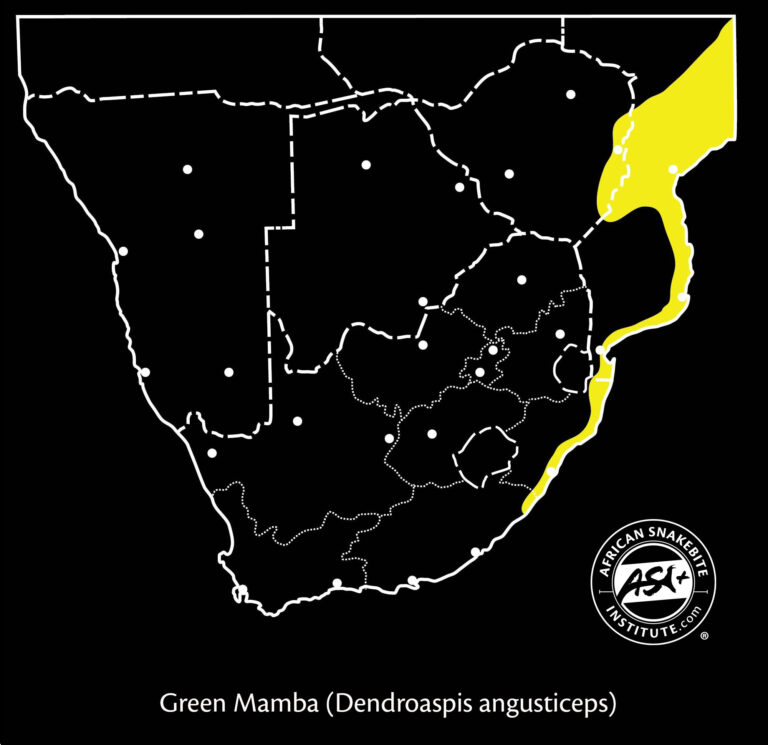
Colour and size
Most Green Mambas encountered in the wild are large adults, usually over 1,2 m in length. The only other large green snake is the Boomslang. It is therefore quite easy to identify adults. It becomes tricky when juvenile Green Mambas are encountered. They hatch around March-April and are olive to turquoise in colour, usually with a lighter green head and large olive eyes. This makes them quite distinct from the other harmless green snakes. They hatch at around 30-40 cm in length. Adult Green Mambas are bright green, with a velvety appearance and may have the occasional scattered yellow scale on the body. The underside is green in Green Mambas whereas most other harmless green snakes have a white, cream or yellowish belly.
The maximum length of a Green Mamba is around 2,5 meters although they are seldom encountered over 2 m.
Head shape
The Green Mamba has a distinct long head shape. Often said to look like a coffin from the top – the side profile also shows an elongated head and the so-called “smile’ of a mamba. Green mambas have small eyes that are usually an olive colour. Most of the harmless green snakes have large, dark eyes while some have bright yellow or red in the iris.
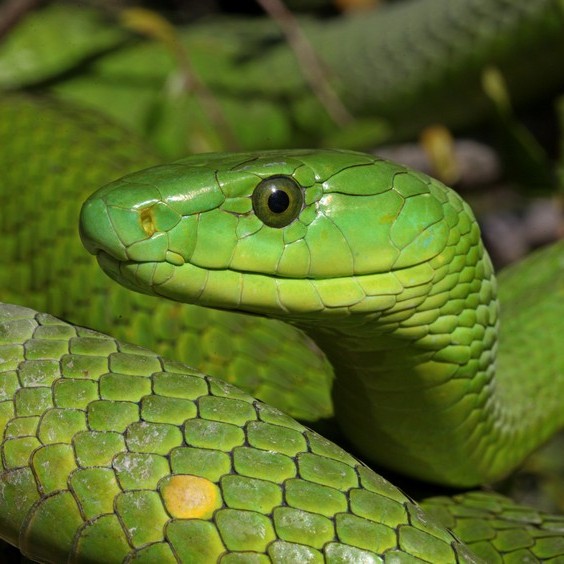
Green Mambas are elusive, secretive snake that are generally found in the canopy of coastal forests or moist savanna where they hunt birds and small rodents. They are shy and avoid humans, disappearing into thick vegetation when disturbed. They are not commonly seen due to their secretive lifestyle. Most of the harmless green snakes in the genus Philothamnus are mistaken for Green Mambas and often killed. Green Mambas are docile snakes and bites are very uncommon. If you find a green snake in your house or garden, call a snake remover to relocate the snake.
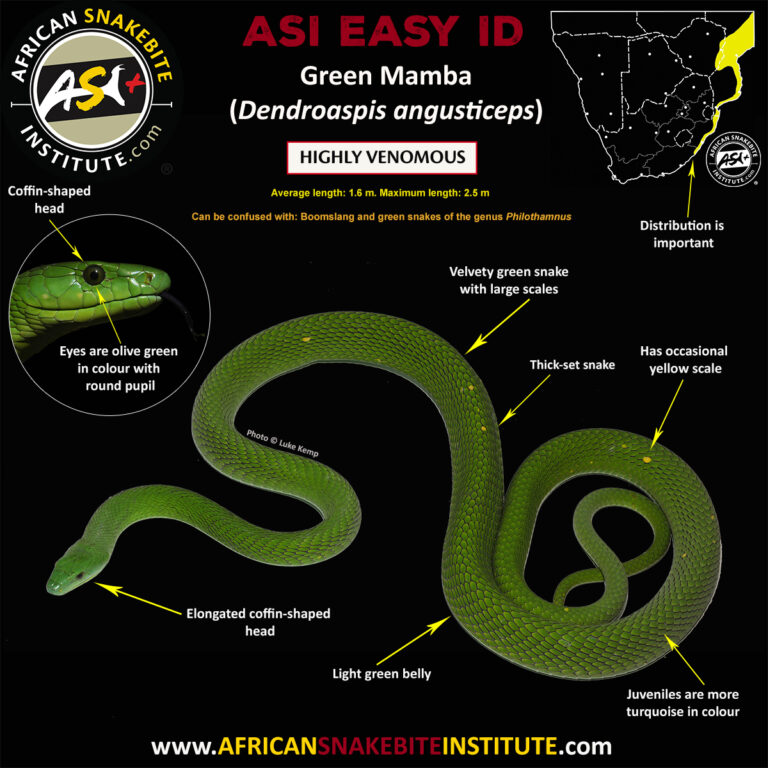
Read more on identifying the Green Snakes of Southern Africa here.
CONTACT US:
Product enquiries:
Caylen White
+27 60 957 2713
info@asiorg.co.za
Public Courses and Corporate training:
Michelle Pretorius
+27 64 704 7229
courses@asiorg.co.za
 ASI Combo C
R1,680.00
ASI Combo C
R1,680.00
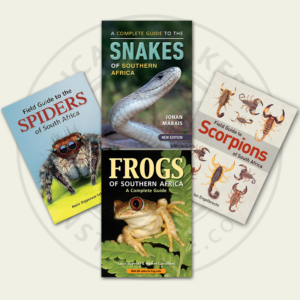 Rangers Book Combo 2
Rangers Book Combo 2
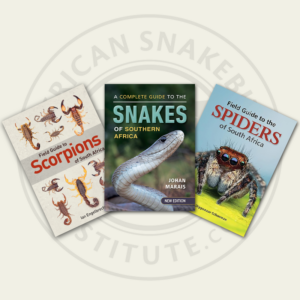 Rangers Book Combo 1
Rangers Book Combo 1

Join our WhatsApp Channel for free information about snakes & snakebite as well as notifications of our latest specials!
Want to attend the course but can’t make it on this date?
Fill in your details below and we’ll notify you when we next present a course in this area:
Want to attend the course but can’t make it on this date?
Fill in your details below and we’ll notify you when we next present a course in this area:
Want to attend the course but can’t make it on this date?
Fill in your details below and we’ll notify you when we next present a course in this area:
Want to attend the course but can’t make it on this date?
Fill in your details below and we’ll notify you when we next present a course in this area:
Want to attend the course but can’t make it on this date?
Fill in your details below and we’ll notify you when we next present a course in this area:
Want to attend the course but can’t make it on this date?
Fill in your details below and we’ll notify you when we next present a course in this area:
Want to attend the course but can’t make it on this date?
Fill in your details below and we’ll notify you when we next present a course in this area:
Want to attend the course but can’t make it on this date?
Fill in your details below and we’ll notify you when we next present a course in this area:
Want to attend the course but can’t make it on this date?
Fill in your details below and we’ll notify you when we next present a course in this area:
Before you download this resource, please enter your details:
Before you download this resource, would you like to join our email newsletter list?